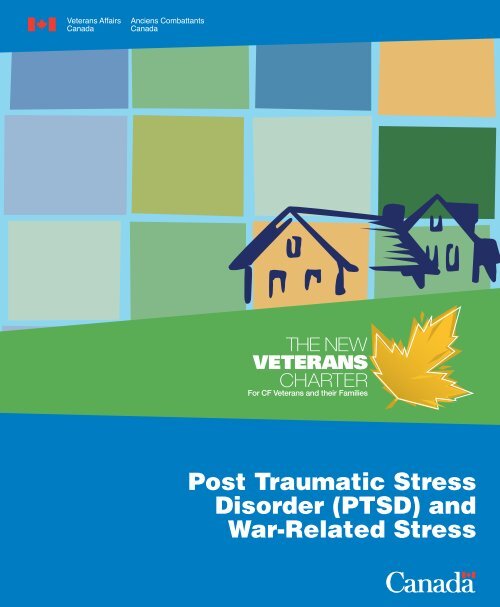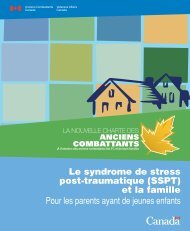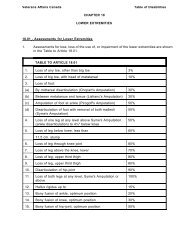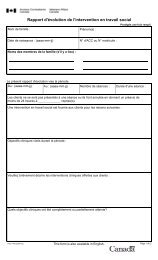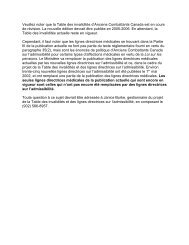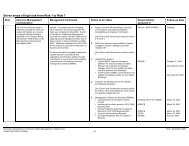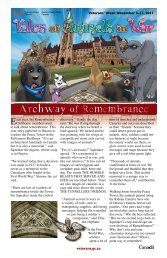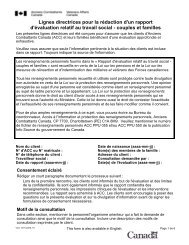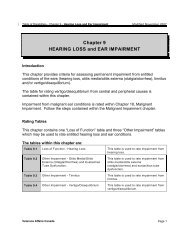Post Traumatic Stress Disorder (PTSD) and War-Related Stress
Post Traumatic Stress Disorder (PTSD) and War-Related Stress
Post Traumatic Stress Disorder (PTSD) and War-Related Stress
- No tags were found...
You also want an ePaper? Increase the reach of your titles
YUMPU automatically turns print PDFs into web optimized ePapers that Google loves.
<strong>Post</strong> <strong>Traumatic</strong> <strong>Stress</strong><strong>Disorder</strong> (<strong>PTSD</strong>) <strong>and</strong><strong>War</strong>-<strong>Related</strong> <strong>Stress</strong>
AcknowledgementThis information has been adapted fromthe publication <strong>Post</strong>-<strong>Traumatic</strong> <strong>Stress</strong><strong>Disorder</strong> (<strong>PTSD</strong>) <strong>and</strong> <strong>War</strong> <strong>Related</strong> <strong>Stress</strong>,an information h<strong>and</strong>book producedby the National Centre for <strong>War</strong>-<strong>Related</strong> <strong>PTSD</strong> which is a collaborativepartnership between the CommonwealthDepartment of Veterans’ Affairs, theUniversity of Melbourne <strong>and</strong> the Austin<strong>and</strong> Repatriation Medical Centre.Veterans Affairs Canada wishes to thankthe National Centre for providingus with permission to reproduce theinformation.How to Use this BookA large amount of information <strong>and</strong>advice is contained in these pages whichmeans that you may want to read asmall bit at a time, slowly <strong>and</strong> carefully,rather than trying to master it all in onego. You may also feel more comfortablereading this book with your partner,other family members or close friends.This will allow you to share informationas you read so that you can better discusshow it may apply to you or the peopleyou care about.La présente publication est disponible enfrançais sous le titre Le syndrome de stresspost-traumatique (SSPT) et le stress lié à laguerre.This publication is available upon request in other formats.Web site: www.vac-acc.gc.caToll free: 1-866-522-2122Reprinted February 2008© Copyright Her Majesty the Queen in Right of Canada, represented by the Minister of Veterans Affairs, 2006.Cat. No.: V32-95/2006EISBN: 0-662-42626-6Printed in Canada
<strong>Post</strong>-<strong>Traumatic</strong> <strong>Stress</strong> <strong>Disorder</strong> (<strong>PTSD</strong>) <strong>and</strong><strong>War</strong>-<strong>Related</strong> <strong>Stress</strong>Table of ContentsInformation for Veterans <strong>and</strong> their FamiliesBackground Information ....................................................................... 1What is <strong>PTSD</strong>? ......................................................................................... 1What is a <strong>Traumatic</strong> Event? ....................................................................... 2Common Symptoms of <strong>PTSD</strong> .......................................................... 3Intrusive Symptoms ................................................................................. 3Avoidance Symptoms ................................................................................ 4Arousal Symptoms .................................................................................... 5Why do <strong>Traumatic</strong> <strong>Stress</strong> Symptoms Develop? .......................................... 5Associated Problems ............................................................................ 7Depression .................................................................................................. 7Anxiety ...................................................................................................... 8Alcohol <strong>and</strong> Drugs ...................................................................................... 9Impact on Relationships <strong>and</strong> Work ............................................................. 9Family Functioning ..................................................................................... 10Occupational Functioning .......................................................................... 11
Coping .................................................................................................. 12Coping Yourself ............................................................................... 12Coping Within a Family .................................................................. 15Sleeping Better ................................................................................. 16Treatment ........................................................................................... 17Stabilization <strong>and</strong> Engagement .......................................................... 17Education <strong>and</strong> Information ............................................................. 18Symptom Management .................................................................... 19Anxiety Management ....................................................................... 20Anger Management ......................................................................... 20Management of Depression ............................................................. 21Medication Self-Management .......................................................... 21Substance Abuse .............................................................................. 22Sleep Disturbance ............................................................................ 22Relationship Difficulties .................................................................. 22Exposure Therapy – Confronting Feared Situations ......................... 23Exposure Therapy – Confronting the Memories .............................. 24Cognitive Restructuring ................................................................... 24Psychodynamic Psychotherapy ......................................................... 25Relapse Prevention ........................................................................... 26Alternative <strong>and</strong> Adjunctive Treatments ............................................. 26
Background InformationWhether in the military or as a civilian,at some point during our lives nearly allof us will experience a traumatic eventthat will challenge our view of the worldor ourselves. Depending upon a range offactors, some people’s reactions may lastfor just a short period of time, while othersmay experience more long-lasting effects.Why some people are affected more thanothers has no simple answer. In Canada,it is estimated that up to 10% of war zoneVeterans — including war service Veterans<strong>and</strong> peacekeeping forces — will go on toexperience a chronic condition known aspost-traumatic stress disorder (<strong>PTSD</strong>),while others may experience at least someof the symptoms associated with thiscondition.What is <strong>PTSD</strong>?<strong>PTSD</strong> is a psychological response to theexperience of intense traumatic events,particularly those that threaten life. Itcan affect people of any age, culture orgender. Although we have started to heara lot more about it in recent years, thecondition has been known to exist at leastsince the times of ancient Greece <strong>and</strong> hasbeen called by many different names. Inthe American Civil <strong>War</strong> it was referred toas “soldier’s heart,” in the First World <strong>War</strong>it was called “shell shock,” <strong>and</strong> inthe Second World <strong>War</strong> it was knownas “war neurosis.” Many soldiers werelabelled as having “combat fatigue” whenexperiencing symptoms associated with<strong>PTSD</strong> during combat. In the Vietnam<strong>War</strong>, this became known as a “combatstress reaction.” Some of these peoplecontinued on to develop what becameknown, in 1980, as post-traumatic stressdisorder.<strong>Traumatic</strong> stress can be seen as part ofa normal human response to intenseexperiences. In the majority of people, thesymptoms reduce or disappear over thefirst few months, particularly with the helpof caring family members <strong>and</strong> friends.In a significant minority, however, thesymptoms do not seem to resolve quickly<strong>and</strong>, in some cases, may continue to causeproblems for the rest of the person’s life.It is also common for symptoms to varyin intensity over time. Some people gofor long periods without any significantproblems, only to relapse when they haveto deal with other major life stress. In rarecases, the symptoms may not appear formonths, or even years, after the trauma.www.vac-acc.gc.ca
What is a <strong>Traumatic</strong> Event?Trauma is a very personal thing. Whattraumatizes one person can be of lesssignificance to others. This variation inpeoples’ reactions occurs because of theirindividual personality, beliefs, personalvalues, <strong>and</strong> previous experiences (especiallyof other traumatic events in their life).It also occurs because each person’sexperience of the incident is unique.However, in all cases the individual hasexperienced a threatening event that hascaused him or her to respond with intensefear, helplessness, or horror.For military Veterans, the trauma mayrelate to direct combat duties, being ina dangerous war zone, or taking part inpeacekeeping missions under difficult<strong>and</strong> stressful conditions. For civilians, thetrauma can stem from either man-madeevents (such as physical or sexual assault,accidents, <strong>and</strong> witnessing the death orinjury of others) or natural disasters(such as fires, earthquakes, floods, <strong>and</strong> icestorms). There are no hard <strong>and</strong> fast rulesto define trauma.www.vac-acc.gc.ca
Common Symptomsof <strong>PTSD</strong><strong>PTSD</strong> is characterized by three maingroups of problems. They can beclassified under the headings of intrusive,avoidance <strong>and</strong> arousal symptoms.Intrusive SymptomsMemories, images, smells, sounds,<strong>and</strong> feelings of the traumatic event can“intrude” into the lives of individualswith <strong>PTSD</strong>. Sufferers may remain socaptured by the memory of past horrorthat they have difficulty paying attentionto the present. People with <strong>PTSD</strong> reportfrequent, distressing memories of theevent that they wish they did not have.They may have nightmares of the eventor other frightening themes. Movement,excessive sweating, <strong>and</strong> sometimes evenacting out the dream while still asleepmay accompany these nightmares. Theysometimes feel as though the events werehappening again; this is referred to as“flashbacks” or “reliving” the event. Theymay become distressed, or experiencephysical signs such as sweating, increasedheart rate, <strong>and</strong> muscle tension whenthings happen which remind them ofthe incident. Overall, these “intrusive”symptoms cause intense distress <strong>and</strong> canresult in other emotions such as grief,guilt, fear or anger.Intrusive Symptoms of<strong>PTSD</strong>:• Distressing memories or imagesof the incident;• Nightmares of the event or otherfrightening themes;• Flashbacks (reliving the event);• Becoming upset when remindedof the incident; <strong>and</strong>• Physical symptoms, such assweating, increased heart rate, ormuscle tension when remindedof the event.www.vac-acc.gc.ca
Avoidance SymptomsMemories <strong>and</strong> reminders of traumaticevents are very unpleasant <strong>and</strong>usually lead to considerable distress.Therefore, people with <strong>PTSD</strong> oftenavoid situations, people, or events thatmay remind them of the trauma. Theyoften try not to think about, or talkabout, what happened, <strong>and</strong> attemptto cut themselves off from the painfulfeelings associated with the memories.In their attempts to do this, they oftenwithdraw from family, friends, <strong>and</strong>society <strong>and</strong> begin to do less <strong>and</strong> less.This may help them to shut out thepainful memories, but it can also leadto a feeling of not belonging to the restof society <strong>and</strong> no longer taking part inactivities they used to enjoy. In this waythe person can become “numb” to theirsurroundings <strong>and</strong> not experience normaleveryday emotions such as love <strong>and</strong>joy, even toward those close to them.Such reactions can lead to depression,feelings of isolation <strong>and</strong> problems withinthe family. They can also lead to severeproblems with motivation — peoplewith <strong>PTSD</strong> often find it hard to makedecisions <strong>and</strong> get themselves going. Theymay have difficulty making the effortto help themselves or even to do thingsthat they would previously have foundenjoyable or easy. This can be very hardfor family <strong>and</strong> friends, who often thinkthat the sufferer is just being lazy ordifficult.<strong>PTSD</strong> Avoidance/Numbing Symptoms:• Trying to avoid any remindersof the trauma, such as thoughts,feelings, conversations activities,places <strong>and</strong> people;• Gaps in memory - forgettingparts of the experience;• Losing interest in normalactivities;• Feeling cut-off or detached fromloved ones;• Feeling flat or numb; <strong>and</strong>• Difficulty imagining a future.www.vac-acc.gc.ca
Arousal SymptomsOften people who have experienced atrauma have been confronted with theirown mortality. Their assumptions <strong>and</strong>beliefs that the world is safe <strong>and</strong> fair, thatother people are basically good, <strong>and</strong> that“it won’t happen to me,” may be shatteredby the experience. After the event, thesepeople often see danger everywhere<strong>and</strong> become “tuned in” to threat. As aconsequence, they may become jumpy, onedge, <strong>and</strong> feel constantly on guard. Thiscan lead to being overly alert or watchful<strong>and</strong> to having problems concentrating(for example, not able to read a bookfor long, getting only a small amount ofwork completed in a few hours, easilydistracted). Disturbed sleep is verycommon.Anger is often a central feature in <strong>PTSD</strong>,with sufferers feeling irritable <strong>and</strong> proneto angry outbursts with themselves, othersaround them, <strong>and</strong> the world in general.Many Veterans feel let down, ab<strong>and</strong>oned,<strong>and</strong> judged by others. They may havea sense of betrayal about the way theywere treated by a range of people on theirreturn home or about things that havehappened since. These feelings of betrayaloften result in bitterness <strong>and</strong> anger. Somepeople only express their anger verbally(which can still be very damaging). Othersbecome physically aggressive <strong>and</strong> violentto property or people, even to those whoare closest to them. Often Veterans feelunable to control their anger. The powerof their anger may be frightening for them<strong>and</strong> they often feel considerable remorseafterward. Such symptoms frequentlycause major problems at work, as well aswith family <strong>and</strong> friends.Arousal Symptomsof <strong>PTSD</strong>:• Sleep disturbance;• Anger <strong>and</strong> irritability;• Concentration problems;• Constantly on the look-out forsigns of danger; <strong>and</strong>• Jumpy, easily startled.Why Do <strong>Traumatic</strong> <strong>Stress</strong>Reactions Develop?It is important to underst<strong>and</strong>that <strong>PTSD</strong> often is linked to anoverwhelming experience, or seriesof events, that is hard to accept orunderst<strong>and</strong>. It doesn’t fit with our viewof the world or ourselves — the way wethink things are or should be. Humanbeings have a natural tendency to try<strong>and</strong> make sense of things that happenaround them. When people experiencea trauma, the event keeps comingback into their mind in an attemptto make sense of what happened.This is a natural way of trying to dealwith, or come to terms with, difficultexperiences <strong>and</strong> seems to work well forwww.vac-acc.gc.ca
many stressful life events. However, dueto the high level of distress associatedwith memories of more severe trauma,the thoughts <strong>and</strong> feelings tend to bepushed away to protect the person fromthis distress. The result is that while thememory may go away for a period oftime, the need for it to be dealt with hasnot been addressed <strong>and</strong> it keeps comingback. The movement backward <strong>and</strong>forward from intrusive thoughts <strong>and</strong>feelings about the trauma to avoidance<strong>and</strong> numbing can then continue almostindefinitely unless the cycle is addressedin some way.Throughout this, alternating betweenshort bursts of painful memories <strong>and</strong>periods of avoidance <strong>and</strong> numbing, thesense of feeling keyed-up persists. Thetraumatized person has been through anevent that potentially threatened theirlife, or the life of someone else, so themind <strong>and</strong> body stay on alert to makesure that it won’t miss any sign in thefuture that such an event may recur. Itis safer to get it wrong by overestimatinga potential threat than to risk thepossibility of missing any future threat.The persistent activation of this threatdetection system, however, leaves thetraumatized person feeling keyed-up oron edge much of the time. In addition,the threat detection system is so sensitivethat it is constantly going off when thereis no danger, in a way that interfereswith the person’s capacity to live anormal <strong>and</strong> happy life.A similar explanation exists with regardto anger. Anger was useful in battle orother situations of threat. It hypes usup <strong>and</strong> promotes our survival — it mayoften be an adaptive way to respond toa life threatening situation <strong>and</strong> certainlybetter than being immobilized with fear.Again, however, it is no longer useful forour survival once the danger has passed.In fact, as we all know, it starts to causeserious problems in our day-to-day lives.<strong>Traumatic</strong> stress reactions are, therefore,sensible <strong>and</strong> adaptive both as part ofsurvival during the trauma <strong>and</strong> inattempts to come to terms with thetrauma afterward. Once we recognizewhere these symptoms come from,it is easier to underst<strong>and</strong> the typicaltraumatic stress reactions. The difficultpart is letting go of aspects of thesereactions that have ceased to providebenefit <strong>and</strong> are primarily interferingwith the traumatized person’s qualityof life.<strong>Traumatic</strong> stress reactions are,therefore, sensible <strong>and</strong> adaptive both aspart of survival during the trauma <strong>and</strong>in attempts to come to terms with thetrauma afterward. Once we recognizewhere these symptoms come from,it is easier to underst<strong>and</strong> the typicaltraumatic stress reactions. The difficultpart is letting go of aspects of thesereactions that have ceased to providebenefit <strong>and</strong> are primarily interferingwith the traumatized person’s qualityof life.www.vac-acc.gc.ca
Associated Problems<strong>PTSD</strong> is not the only psychologicalresponse to trauma. People may developa range of other problems that canaffect their quality of life, their ability torelate to other people <strong>and</strong> their capacityfor work. These problems may occuron their own or as part of the <strong>PTSD</strong>.Many of these problems are thought tobe the result of people trying to controleither themselves <strong>and</strong> their symptoms(such as alcohol <strong>and</strong> drug abuse) or theirenvironment (such as avoidance behaviour<strong>and</strong> angry outbursts). Also, many of thesigns are directly related to stress (suchas skin complaints <strong>and</strong> general aches<strong>and</strong> pains). Overall, the most commonlyassociated problems in <strong>PTSD</strong> are thoserelating to anxiety, depression, <strong>and</strong> alcoholor drug use. These can be very disabling tothe person suffering from them <strong>and</strong> mayaffect family members <strong>and</strong> co-workers.DepressionDepression is a general state of lowmood <strong>and</strong> a loss of interest or pleasurein activities that were once enjoyed. Lifebecomes flat <strong>and</strong> grey, <strong>and</strong> nothing seemsfun, exciting, or enjoyable anymore.These depressed states can be very intense,leading to a total withdrawal from others<strong>and</strong> a state of numbness, or they can belower in intensity - just feeling “down inthe dumps.” They may last for as littleCommon Symptomsof Depression:• Feeling low, down in thedumps, miserable;• Feelings of worthlessness,helplessness, <strong>and</strong> hopelessness;• Lack of energy, easily tired;• Lack of enthusiasm, difficultieswith motivation;• Loss of interest <strong>and</strong> pleasure innormal activities;• Lack of appetite <strong>and</strong> weightloss;• Loss of sexual interest;• Difficulty sleeping or sleepingtoo much;• Poor concentration, memory,<strong>and</strong> decision making; <strong>and</strong>• Thoughts of suicide or death.www.vac-acc.gc.ca
as a few hours or as long as months oreven years. In more severe cases, theperson may believe that life is no longerworth living. Around 50% of peoplewith chronic <strong>PTSD</strong> also have significantproblems with depression.Depression is often associated with guilt.People with <strong>PTSD</strong> often report strongfeelings of guilt, shame, <strong>and</strong> remorse. Thismay be about the fact that they survivedwhile others did not; it may be aboutwhat they had to do to survive; it may berelated to things they did about whichthey now feel ashamed. The nature of waris such that there are often no acceptableor “good” options: all options are bad (forexample, kill or be killed). Sometimes theguilt results from trying to apply civilian,or peacetime, st<strong>and</strong>ards to a combatsituation. If we judge our actions then byour st<strong>and</strong>ards now, we may end up feelingguilty <strong>and</strong> ashamed. For some Veterans,those feelings can be very damaging <strong>and</strong>can get in the way of recovery. They arehard to work on, but it is important totry <strong>and</strong> reduce the intensity <strong>and</strong> strengthof guilt by challenging the thoughts <strong>and</strong>beliefs associated with those feelings.AnxietyAnxiety is best described as a state ofapprehension <strong>and</strong> worry that somethingunpleasant is about to happen. It is oftenaccompanied by a range of physicalsymptoms which are, in themselves,very frightening. Sometimes peopleexperiencing these symptoms believe thatthey are going to die from a heart attackor go crazy.Anxiety can be specific to certainsituations (such as social events, crowdedplaces, or public transport), or it can bea general state of worry. It can becomevery disabling, as people tend to avoida wide range of situations that makethem anxious. The symptoms are veryunpleasant <strong>and</strong> may cause a great deal ofdistress.www.vac-acc.gc.ca
Common Symptomsof Anxiety:• Apprehension, fearfulness, orterror;• Shortness of breath <strong>and</strong> tightnessin the chest;• Palpitations <strong>and</strong> increased heartrate;• Sweating;• Shaking, trembling, or dizziness;• Fear of losing control or goingcrazy;• Excessive worry;• Feeling restless <strong>and</strong> on edge;• Muscle tension; <strong>and</strong>• Physical disorders (e.g., skincomplaints, stomach upsets,aches <strong>and</strong> pains).Alcohol <strong>and</strong> DrugsIn an attempt to cope with the unpleasantsymptoms, many people turn to alcoholor other drugs. Around 50% of males <strong>and</strong>25% of females with chronic <strong>PTSD</strong> havemajor problems with alcohol <strong>and</strong> drugs;the figures for Veterans are even higher.The most common problem drug isalcohol but many people also abuse otherillicit drugs (for example, marijuana)or prescription medications. Drug <strong>and</strong>alcohol abuse impairs the person’s abilityto function effectively <strong>and</strong> to relate toother people. It can cause great difficultiesin areas such as relationships, work,finances, <strong>and</strong> can cause violent behaviour.Impact on Relationships<strong>and</strong> WorkTraumatized people can become“consumed” or overwhelmed by theirfeelings. They may become preoccupiedwith survival in situations that theyperceive as threatening. This may leadothers to believe that individuals with<strong>PTSD</strong> are selfish, thinking only ofthemselves. This “egocentric” behaviour,together with the symptoms of <strong>PTSD</strong>, canimpact on relationships with family <strong>and</strong>friends, as well as on the person’s abilityto function at work, hobbies, or other lifeareas.www.vac-acc.gc.ca
10Family Functioning<strong>PTSD</strong> can directly affect family life ona number of levels. A common sign of<strong>PTSD</strong> is the inability or difficulty to feel<strong>and</strong> express emotions (for example, love<strong>and</strong> enthusiasm). This may lead partners,family members, <strong>and</strong> friends to feel“pushed away” <strong>and</strong> rejected. This, in turn,can leave the sufferer feeling isolated <strong>and</strong>unloved.In an attempt to reassure themselvesthat they are normal, traumatized peoplesometimes become sexually dem<strong>and</strong>ing,yet still find it difficult to be emotionallyintimate. On the other h<strong>and</strong>, feelings ofworthlessness, anxiety, <strong>and</strong> depressionmay result in a complete loss of interestin sex <strong>and</strong> difficulties becoming aroused.This tends to compound feelings ofinadequacy or guilt <strong>and</strong> their partner maybecome resentful <strong>and</strong> hurt.Traumatized people often feel a moregeneral sense of detachment - feelinggenerally “cut-off” from other people.This often leads to reduced participationin activities <strong>and</strong> hobbies that they usedto enjoy before the trauma. This absenceof shared enjoyable activities makes itdifficult to have a normal family life. Thepartner is often left with the full burdenof running the family. In some cases, agreat deal of time is spent focussing onthe Veteran’s problems at the expense ofthe partner’s needs.Traumatized people are often tired, due todisturbed sleep <strong>and</strong> depression, <strong>and</strong> canbecome cranky <strong>and</strong> irritable. The inabilityto get a good night’s sleep frequentlymeans that the person simply has lessenergy to offer the relationship. Theymay say hurtful things without reallyconsidering the implications of what theyare saying.Traumatized people may try tocompensate for their feelings of fear <strong>and</strong>vulnerability by using anger to pre-emptany perceived potential threat. As oneVeteran stated “the best form of defenceis attack.” This fear can also motivatetraumatized people to act in controllingways toward family members in attemptsto protect them from perceived dangers.Over a period of time, these problemswith family <strong>and</strong> friends can severelyerode trust <strong>and</strong> intimacy. Eventually, itmay become too much for those closeto the individual. Following trauma, thelikelihood of separation <strong>and</strong> divorce isconsiderably increased.www.vac-acc.gc.ca
11Occupational FunctioningThe traumatized Veteran may havedifficulty coping with pressure at work.Irritability, jumpiness, mood swings, poorconcentration, <strong>and</strong> memory problemsmay lead to disputes in the workplace <strong>and</strong>frequent job changes.They may be intolerant of other peoples’inefficiency, comparing civilian lifewith the organized, military way. SomeVeterans with <strong>PTSD</strong> adopt a workaholicpattern, shutting themselves away in theirwork <strong>and</strong> putting in very long hours.This seems to be part of the avoidancecomponent of <strong>PTSD</strong> — keeping verybusy helps to prevent the memories <strong>and</strong>unpleasant thoughts coming back. OtherVeterans find that their problems prohibitthem from working effectively at all.The decision to stop work is a difficultone. The Veteran needs to weigh upthe personal cost of remaining in theworkforce against the benefits of tryingto continue work, perhaps with reducedhours or responsibility (for example, senseof belonging, achievement, self esteem,<strong>and</strong> financial well-being). Althoughthe benefits of a regular pension <strong>and</strong>retirement from the workforce may seemvery appealing, this is not a decision thatshould be taken lightly.Problems such as irritability,mood swings, poor concentration,<strong>and</strong> memory disturbance canoften interfere with the Veteran’scapacity to work effectively.Alternatively, the Veteran may usea “workaholic” pattern as a way ofattempting to avoid the unpleasantmemories.www.vac-acc.gc.ca
12CopingIt is not very helpful to think of“curing” <strong>PTSD</strong> in a black-<strong>and</strong>-white,all-or-nothing manner. Everyone whoexperiences trauma will be affected by itdifferently. Some of those changes may bepositive — for example, the survivor maybecome stronger in some ways, perhapsmore caring <strong>and</strong> underst<strong>and</strong>ing of others’misfortune. They may find that theexperience has better equipped them todeal with future life stress. Unfortunately,some of the changes will be negative,especially in cases of <strong>PTSD</strong>, <strong>and</strong> copingwith even the smallest frustrations <strong>and</strong>difficulties becomes a major challenge.Some people who develop <strong>PTSD</strong> seem torecover completely <strong>and</strong> are left with littleor no on-going distress <strong>and</strong> impairment.For others, the symptoms may persist<strong>and</strong> the individual must learn to manage<strong>and</strong> cope with them in order to minimizethe effects on their lives. There is muchthat people with <strong>PTSD</strong> can do to helpthemselves deal with the disorder.Coping YourselfThe following is a list of tips that somepeople have found to be useful. Many ofthem are basic common sense, but thatdoes not mean they are unimportant.On the contrary, if you can do the basics(which is not easy) you will go a longway to successfully managing your <strong>PTSD</strong>symptoms.Do not try to do everything at once.When you have read the followingsections, you may wish to stop for a while<strong>and</strong> work out a “plan of action.” Whichstrategies sound particularly useful foryou? Which ones are you prepared totry? We suggest that you select only oneor two to begin with. Work out a planto achieve them, one at a time, <strong>and</strong> setyourself some realistic goals for the nextweek. At the end of the week, review yourprogress: modify your goals if necessary<strong>and</strong>/or try some additional strategiesfor the following week. Over time, youwill gradually develop a range of copingstrategies <strong>and</strong> changes to your lifestylethat will help you to feel more in controlof your symptoms <strong>and</strong> get more out oflife. You may be able to find programsin your local community to assist withsome of these areas. Here are some simplestrategies to help you cope:www.vac-acc.gc.ca
• Eat healthy meals. This sounds sosimple, but how many of us actually doit? A poor diet will increase your stresslevels - if in doubt, talk to your doctoror a dietician.• Get regular aerobic exercise likewalking, jogging, swimming, or cycling.You might want to take the opportunityto go for regular walks with yourpartner. Exercise is vital in effectivelymanaging stress. If you have <strong>PTSD</strong>,your body is almost constantly gearedup for “fight or flight.” Exercise helps toburn up those chemicals that are hypingyou up <strong>and</strong> will help you to becomemore relaxed.• Get enough rest, even if you can’t sleep.Rest will help to increase your reservesof strength <strong>and</strong> energy. You may wish totry some kind of meditation, yoga, orrelaxation exercises.• Establish daily routines (e.g., go to bedat a set time, get out of bed at a set time,plan activities for the day). Routine isvery important in helping us to feel incontrol <strong>and</strong> to function effectively.• Set small, realistic goals to help tackleobstacles. At first, things may seeminsurmountable but broken downinto small steps they are manageable.Some people like to keep lists of tasksto accomplish when they feel capable,crossing them off as they are completed.This can be very rewarding, <strong>and</strong> helpyou to acknowledge that you areachieving something.• Redefine your priorities <strong>and</strong> work outwhat is, <strong>and</strong> is not, achievable. Try to berealistic - expect neither too much nortoo little of yourself. Then focus yourenergy <strong>and</strong> resources on those priorities.• To help stop the constant streamof worrying <strong>and</strong> anger-producingthoughts, set aside a specific timeeach day for thinking. Give yourselfpermission to reflect <strong>and</strong> deal withissues related to the trauma atappropriate times for a defined period(perhaps 30 minutes each day). Ifunwanted thoughts come into yourmind at other times, gently remindyourself that you will be thinking aboutit later in the day.• Ask for support <strong>and</strong> help from yourfamily, friends, church, or othercommunity resources when you needit. This is not a sign of weakness. Ingeneral, other people are very keen tohelp as long as you let them know whatyou want.• Join or develop support groups - sharingexperiences with others who underst<strong>and</strong>is often useful.• Continue to educate yourself <strong>and</strong> yourfamily about reactions to trauma. Agood underst<strong>and</strong>ing of <strong>PTSD</strong> <strong>and</strong>related disorders is important in comingto terms with your experiences <strong>and</strong>beginning to deal with your problems.13www.vac-acc.gc.ca
14• Look after your partner, if you haveone. Try to clarify your feelings <strong>and</strong>assumptions about him or her, <strong>and</strong>check out whether those feelings<strong>and</strong> assumptions are accurate. Manyproblems are caused by one partnerjumping to conclusions or assuming thatthey know what the other is thinking.Remember that men <strong>and</strong> women tendto react differently. Women tend to becaretakers <strong>and</strong> put others first. Men tendto have more difficulty acknowledging<strong>and</strong> expressing feelings of sadness <strong>and</strong>helplessness <strong>and</strong> believe in “toughing itout.” We all like our partners to say <strong>and</strong>do things that show that they value <strong>and</strong>care for us — make an effort to do thisfrom time to time.• Acknowledge unresolved issues <strong>and</strong> behonest with yourself: what do you stillfeel hurt, frightened, angry or guiltyabout? Recognizing, <strong>and</strong> admittingto, the issues is an important first stepto recovery. Use the hurt <strong>and</strong> painas a motivator to make the necessarychanges to heal (i.e., if you don’t want tocontinue feeling like that, what can youdo about it?).• Talk to your children. Try to besupportive <strong>and</strong> patient. Obviously, thisis not always easy, but losing control <strong>and</strong>getting angry only makes things worse.Set an example by expressing yourfeelings gently, controlling your anger,<strong>and</strong> showing problem solving skills indealing with family difficulties as theyarise. (What exactly is the problem? Let’swork out a plan to h<strong>and</strong>le it).• When you’re feeling rotten, rememberthat those around you are probably alsounder stress.• Focus on your strengths <strong>and</strong> copingskills. It may not feel like it at times,but you have many strengths <strong>and</strong>strategies to deal with difficult times.• Try not to use your <strong>PTSD</strong> or yourwar experiences as an excuse forhurting yourself or others. There is noexcuse for being violent, aggressive,or otherwise mistreating other humanbeings. It is important that you takeresponsibility for your own behaviour.• Remember that you are not alone. Lotsof other Veterans over the centurieshave experienced these kinds ofproblems. There is always hope.Simple Strategies:• Eat healthy meals;• Exercise regularly;• Get lots of rest;• Establish a daily routine;• Identify priorities <strong>and</strong> set realisticgoals;• Allow yourself a little time each dayto reflect on the trauma;• Ask for support;• Educate yourself about <strong>PTSD</strong>;• Care for your partner <strong>and</strong> yourchildren;• Acknowledge unresolved issues;• Focus on your strengths;• Take responsibility for your illness; <strong>and</strong>• Remember you are not alone.www.vac-acc.gc.ca
Coping Within a FamilyPartners <strong>and</strong> close friends are often ata loss as to how to help someone with<strong>PTSD</strong>. There are several things that lovedones can do to help the traumatizedperson <strong>and</strong> you may find the followingsuggestions useful:• If possible, listen <strong>and</strong> empathize whenthe traumatized person wants to talk.Remember that it may be very hardfor them to express what they’re goingthrough. A sympathetic listener isimportant in minimizing the tendenciesof people with <strong>PTSD</strong> to withdraw <strong>and</strong>“shut down.” It is best not to say “Iunderst<strong>and</strong> what you’re feeling” (youprobably don’t, since you haven’t beenthrough the same experiences). Instead,show your empathy by comments suchas: “It must be really difficult for you;I can see that it upsets you; is thereanything I can do to help?”• Spend time with the traumatizedperson. There is no substitute forpersonal presence. Just keep doing theusual things that people do together. Donot feel that you have to talk about thetrauma or be their counsellor. Just beingwith people who care about them is veryimportant for traumatized individuals.Equally, try to respect the person’s needfor privacy <strong>and</strong> private grief at times.• Don’t tell survivors that they are “luckyit wasn’t worse” or to “pull themselvestogether <strong>and</strong> get over it.” They are notconsoled by such statements. Tell them,instead, that you’re sorry they wereinvolved in such an event, <strong>and</strong> that youwant to underst<strong>and</strong> <strong>and</strong> assist them.• Reassure them that they are now safe.• Care about each other. Give hugs. Telleach other how much you appreciatethe other. Offer praise. Make a pointof saying something nice to eachother every day. Good relationshipsare characterized by lots of positiveinteractions, but they take a lot of hardwork.• Don’t be afraid to suggest that they seea clinical psychologist, psychiatrist, orcounsellor, or that they seek supportfrom peer groups. But remember to dothis in a tactful <strong>and</strong> caring manner - notin the middle of an argument!• Laugh. Use humour (although notabout the traumatic event).15www.vac-acc.gc.ca
16Sleeping BetterSleep disturbance is very common in<strong>PTSD</strong> <strong>and</strong> in depression. Medicationsometimes helps, but it should be usedwith caution <strong>and</strong> only as directed byyour doctor. There are several simple“non-drug” strategies you can try that canbe very helpful in improving sleep:• Get into a regular routine. In particular,get up at the same time each morningeven if you haven’t slept well.• If you are not asleep within 30 minutes,get up for a while before returning tobed. If you don’t drop off within 30minutes, get up again <strong>and</strong> so on.• Try to avoid caffeine (coffee, tea, cola,chocolate) after 6 p.m. Avoid alcohol<strong>and</strong>, if possible, cigarettes after yourevening meal. Try not to eat a mealwithin a couple of hours of going tobed.• Start a gentle exercise routine. Losing abit of weight often helps with sleep.• Don’t do anything in bed except sleep(<strong>and</strong>, perhaps, sex): don’t watch TV,read, do crosswords, or think worrisomethoughts.• Get into the habit of doing somethingrelaxing before bed: listen to a relaxationtape or some soothing music, have awarm bath, slow down!• Try not to worry about not sleeping:the more you worry about it, the lesslikely you are to drop off to sleep. Youcan survive without much sleep, eventhough you will be tired.• Sleep, like any habit, takes a whileto change. Try to stick to the aboveguidelines for at least two weeks beforedeciding whether or not they help.www.vac-acc.gc.ca
17TreatmentObtaining appropriate treatment for<strong>PTSD</strong> is not always as straightforward asone might think. First, the person has toaccept that there is something wrong <strong>and</strong>see the benefit of seeking help. Gettinghelp is often frightening — for many,it is a leap into the unknown — butwithout this first step, progress is notpossible. Secondly, it is not always easyto find a professional who underst<strong>and</strong>s<strong>PTSD</strong> <strong>and</strong> to whom you can relate <strong>and</strong>trust. Sometimes it may be necessary totry a few different sources of help untilyou find the right one for you. Try askingyour doctor, community health centre,or Veterans’ organization for advice orprofessional references. There are manydifferent aspects to treatment <strong>and</strong> manydifferent approaches. However, thissection will deal predominantly withthe most common forms of treatment<strong>and</strong> the ones that have been shown to beeffective. Most require the services of anexperienced mental health professional.It is important to remember thattreatment can be painful <strong>and</strong> hard work.Unfortunately, there is no easy way toget rid of the memories or make themless distressing. There is no magic w<strong>and</strong><strong>and</strong> no “sweet oblivious antidote.” Butthe long term gains can be enormous:effective treatment can dramaticallyassist your recovery, helping you to live anormal life once again.Treatment for <strong>PTSD</strong> often involvesseveral stages:• Crisis stabilization <strong>and</strong> engagement;• Education about <strong>PTSD</strong> <strong>and</strong> relatedconditions;• Strategies to manage the symptoms(such as anxiety, anger, depression,alcohol abuse, sleep problems, <strong>and</strong>relationship problems);• Trauma-focussed therapy (confrontingthe painful memories <strong>and</strong> fearedsituations);• Cognitive restructuring (learningto think more realistically <strong>and</strong>re-evaluating the meaning of the event);<strong>and</strong>• Relapse prevention <strong>and</strong> ongoingsupport.Stabilization of a Crisis <strong>and</strong>Engagement in Treatment<strong>PTSD</strong> symptoms are not usuallyconstant in their intensity. Rather, theytend to fluctuate <strong>and</strong> there may betimes when they “flare up” or worsen.Although this can occur at any time, it ismost likely to be triggered by things suchas anniversaries or other reminders of thetrauma <strong>and</strong> stressful life events such asfamily arguments, problems at work, orthe death of a friend or relative. Becausecrises can occur at any time of the day orwww.vac-acc.gc.ca
18night, <strong>PTSD</strong> sufferers <strong>and</strong> their familiesshould know how to access 24-hourtelephone counselling services. Althoughtalking on the telephone to someone youdo not know may not sound like muchhelp, it can often be very effective. Itmay help you get through the night orweekend until other support is available.During especially difficult times it maybe necessary for the Veteran to attendhospital as an in-patient. During his orher stay, the crisis may be treated withmedication, psychotherapy, <strong>and</strong> generalcounselling. As well as stabilizing thesymptoms, a brief in-patient stay alsoprovides a “time-out” period for both theVeteran <strong>and</strong> their family to refocus ontheir direction.It is important that any current lifecrises are resolved, or at least put “onhold,” before the real treatment of<strong>PTSD</strong> can begin. It is not possible todevote the necessary concentration,time, <strong>and</strong> energy to your recovery ifyou are constantly worried about yourjob, your relationship, your children, orother important life areas. That is not tosay that you have to be able to solve allthose problems before you can work onyour <strong>PTSD</strong>, but you will need to be ableto put them to one side for a while toconcentrate on your treatment. Therapyis hard work — there is no easy way todo it — <strong>and</strong> you will need to devote allyour personal resources to the task.The first part of treatment will oftenbe devoted to developing a relationshipwith the therapist (or the treatmentteam if you are taking part in a groupprogram). You will need to spend sometime getting to know each other, <strong>and</strong>building trust, if you are to work onthe difficult issues. We call this process“engagement.” For many Veterans with<strong>PTSD</strong>, this is a very difficult process— it may have been a long time sincethey really trusted another person,particularly someone who is not aVeteran. In many cases, you will need totell your therapist about experiences <strong>and</strong>feelings that you have never discussedwith anyone before. We need to recognizethat this is a difficult process that will takea lot of courage, but it will be worth it<strong>and</strong> it is the only way to recovery.Education <strong>and</strong> InformationTrauma can sometimes feel like anincomprehensible cloud that hangs overall areas of the person’s life. The first stepin treatment is to underst<strong>and</strong> exactly whattrauma is, why you have the symptomsyou do <strong>and</strong>, therefore, why it is treatedthe way it is. In this regard, it is hopedthat this information is a first step inunderst<strong>and</strong>ing the disorder.You need to know what the commonsigns <strong>and</strong> symptoms are, <strong>and</strong> you need torecognize that you are not alone - manypeople who have experienced traumaticevents have responded in exactly the sameway as you have. You need to underst<strong>and</strong>www.vac-acc.gc.ca
why the symptoms have appeared- the fact that they were very useful forsurvival while the traumatic events werehappening, but that they are no longeruseful. They have become “maladaptive”<strong>and</strong> now only serve to create problems <strong>and</strong>distress for you.You need to underst<strong>and</strong> what treatmentwill involve <strong>and</strong> how it may affect you.It is very important that you feel able toask your therapist questions about thenature of your problems <strong>and</strong> the processof treatment. He or she will not haveall the answers, but together you willreach a better underst<strong>and</strong>ing of what hashappened <strong>and</strong> how you will recover.Sometimes, people who have beenthrough a traumatic event have troubleunderst<strong>and</strong>ing what happened <strong>and</strong> whyit happened. This is because, when weare under threat, our attention is veryfocussed on the source of the danger <strong>and</strong>we do not take in all the other things thatare happening around us. We may end upwith a distorted <strong>and</strong> confused memoryof the experience, so that it becomesdifficult to underst<strong>and</strong> <strong>and</strong> make senseof the event. This confusion often stopsus from being able to put the experiencebehind us. For this reason, your therapistmay help you to find out more about whathappened during the event. (Althoughwe have put this under the headingof “Education <strong>and</strong> Information,” it isactually something that may happen atseveral stages throughout treatment.)This process is important in beingable to “put the pieces of the jigsawpuzzle together” <strong>and</strong> make sense ofyour experience. A good underst<strong>and</strong>ingof exactly what happened <strong>and</strong> why ithappened often facilitates recovery.Unfortunately, of course, this is not alwayspossible. Sometimes you may never findout exactly what happened or, morecommonly, why it happened <strong>and</strong> you haveto learn to live with that uncertainty.Symptom ManagementAs already noted, <strong>PTSD</strong> has manysymptoms that interfere with thetraumatized person’s daily functioning.Part of treatment usually involvesproviding the person with strategies tocope with <strong>and</strong> manage these symptoms.Medication will often play a part in thisstage of treatment. Unfortunately, suchstrategies rarely make the symptoms goaway altogether. However, they helpsufferers to carry on with their day-to-dayfunctioning, no longer being “helplessvictims” of the symptoms. A range ofstrategies may be used <strong>and</strong> some ofthe more common are outlined below.However, it is important to keep in mindthat the following is just a guide; anexperienced <strong>and</strong> qualified therapist canhelp you accomplish these techniques.19www.vac-acc.gc.ca
20Anxiety ManagementTechniques aimed at reducing levels ofanxiety <strong>and</strong> arousal are an important partof treatment.Anxiety ManagementTechniques:• Relaxation training to reduceoverall levels of anxiety;• Breathing techniques to reducepanic-like symptoms;• Thought-interruption methodsto break the tendency to‘ruminate’ or think excessivelyabout the past;• Rational self-talk to help managehigh anxiety situations <strong>and</strong>depressing thoughts;• Techniques to help you organizeyour time effectively, schedulingenjoyable <strong>and</strong> productiveactivities <strong>and</strong> providing somestructure to your days.Anger ManagementTechniques to reduce levels of anger <strong>and</strong>irritability with others are important.Strategies that are commonly usedinclude:• Education to underst<strong>and</strong> the nature<strong>and</strong> purpose of anger;• Methods of identifying early warningsigns of stress <strong>and</strong> irritability;• Methods of identifying high risksituations <strong>and</strong> how to prepare forthem;• Methods of realistically re-evaluatingthe situation, keeping it in perspective;• Strategies to reduce arousal <strong>and</strong> staycalm in difficult situations;• Effective communication methods(verbal <strong>and</strong> non-verbal);• Differentiating assertive fromaggressive behaviour;• Problem solving strategies to effectivelydeal with disagreements;• Distraction <strong>and</strong> removal techniques toavoid “flare-ups”; <strong>and</strong>• Practice in imagined <strong>and</strong> real-lifesituations.www.vac-acc.gc.ca
21Management of DepressionPeople with <strong>PTSD</strong> frequently developsymptoms of depression.Strategies to Reduce <strong>and</strong>Manage Depression:• Increasing positive, enjoyableevents <strong>and</strong> scheduling these intodaily living;• Resolving the underlyingassumptions <strong>and</strong> beliefs aboutthe self (e.g., “I’m a worthlessfailure”) or the world (e.g.,“Nobody cares about me”) thatcan lead to feelings of sadness <strong>and</strong>depression;• Identifying patterns of depressivethoughts on a day-to-day basis;• Realistically evaluating <strong>and</strong>challenging negative beliefs <strong>and</strong>thoughts; <strong>and</strong>• Rational, realistic copingself-talk.Medication Self-ManagementMedication is frequently used tohelp manage severe <strong>PTSD</strong> symptoms(although, on its own, it will not changethe underlying problems <strong>and</strong> shouldbe combined with other treatments).To minimize unintended difficultiesassociated with medication, thefollowing strategies are frequently used:• Education about the use <strong>and</strong> effect ofthe substance;• Education about possible side-effects<strong>and</strong> activities or substances to avoid;• Methods of keeping track ofmedication use;• Discussing the effects <strong>and</strong> desireto change medication with yourpsychiatrist; <strong>and</strong>• Methods of reducing <strong>and</strong> stoppingmedication intake.www.vac-acc.gc.ca
22Substance AbuseMany people with <strong>PTSD</strong> attempt tocope or “self-medicate” with excessiveamounts of alcohol <strong>and</strong> inappropriatedrug use (including prescribed drugs).Treatment for SubstanceAbuse:• Education about the use <strong>and</strong>effect of the substance;• Decisions regarding totalabstinence versus controlled useof the drug;• Recording “danger” times <strong>and</strong>identifying patterns of use;• Developing coping strategies forhigh risk times;• Assertiveness training for whenothers are applying peer pressure;• Planning <strong>and</strong> scheduling activitiesnot associated with the substance;<strong>and</strong>• Response prevention - methods ofresisting the ‘urge.’Sleep DisturbanceMany sufferers of <strong>PTSD</strong> reportdisturbances of sleep. Several strategiesmay be useful in addressing the difficultyof going to sleep, waking repeatedlythroughout the night, or waking early inthe morning. It is common for therapiststo assist clients in developing a healthysleep routine in line with the suggestionsprovided above. Other strategies,including medication, may be adoptedwhen those are not proving effective.Relationship DifficultiesPeople who have been traumatized oftenlose track of who <strong>and</strong> what they cantrust in the world. This often has a majorimpact on relationships. To address thedifficulties that can occur between couples<strong>and</strong> family members, <strong>PTSD</strong> sufferersare frequently taken through a range ofstrategies to improve relationships.Some of the methods used may includeactive listening (how to really listen toyour partner or children), communicationtraining (how to say effectively whatyou need <strong>and</strong> feel), <strong>and</strong> problem solving(how to solve everyday problems withoutfighting). Some of this may occur with theVeteran alone <strong>and</strong> some with their partner.Separate support <strong>and</strong> counselling for thepartner is often beneficial. Sometimesfamily therapy is provided, where thewhole family meets to address their issues,with the aim of developing a healthyenvironment for all.www.vac-acc.gc.ca
Exposure Therapy –Confronting Feared SituationsAnxiety frequently causes people to stayaway from the frightening situation. It isquite normal for people to want to escapeor avoid situations, thoughts, memories,or feelings that are painful or distressing.However, this is one of the majorimpediments to recovery.Avoidance <strong>and</strong> escape providetemporary relief — the anxiety reduces.Unfortunately, the next time the personencounters that situation, he or she islikely to become anxious long beforeit is planned to occur. We call this“anticipatory anxiety.” The more thesituation is avoided, the more the personcontinues to believe that it is dangerous.Further, even if the person does notavoid, the anxiety may continue to buildonce they are in the situation. You mayhave had this experience in a range ofsituations, such as going to a shoppingcentre or watching a movie about war.Very often people believe that if they donot leave the situation they will “losecontrol,” “go crazy,” “have a heart attack,”or have some other dire consequences. Atthe very least, they are likely to believe thatthe unpleasant feelings will be intolerable.Exposure therapy aims to show that thisis not the case by helping the person toconfront the feared situation. This is donein a very controlled <strong>and</strong> gradual fashion,overseen by therapists who are experiencedwith the procedure, so that discomfort iskept to a minimum. By building uponrepeated successes in facing these fearedsituations, the person is eventually able toconfront them without anxiety <strong>and</strong> theyare no longer avoided.In many ways, this approach is commonsense. Let’s take an example of a little boywho is st<strong>and</strong>ing on the beach when a bigwave knocks him over. He becomes veryfrightened of the sea <strong>and</strong> refuses to goto the beach the next day. How wouldhis mother or father help? In order toovercome the fear, his parents may takehim for a walk along the beach, stayingaway from the sea, holding his h<strong>and</strong> <strong>and</strong>reassuring him. Gradually, they walkcloser <strong>and</strong> closer to the water’s edge.Eventually, the boy is able to go intothe sea again unaided. This is a simpleexample, but exactly the same processapplies to treating more severe <strong>and</strong>complex fears in adults.In conducting exposure treatment,your therapist will work with you inconstructing a hierarchy — a list of fearedsituations in order of difficulty. Treatmentinvolves tackling each item, one at a time,<strong>and</strong> moving on to the next only whenyou are confident to do so. More difficultitems may be broken up into several steps.Exposure treatment can be difficult <strong>and</strong>painful, but it is the most effective way oftreating many anxieties.23www.vac-acc.gc.ca
24Exposure Therapy –Confronting the MemoriesA form of exposure therapy is also used totreat distressing memories of the trauma.In cases of <strong>PTSD</strong>, the memories arethe “feared situation.” These memoriesare so frightening, <strong>and</strong> cause so muchdistress, that the person tries to avoidor escape from them by blocking themout. Often, exposure treatments are usedto assist in confronting the memories.Exposure is only one term used to describethis process. Some people talk about“trauma focus work,” “working throughthe trauma,” “coming to terms with theexperience” or simply “confronting thememories.”Exposure-based treatments are not foreverybody. In some cases, if the memoriesare not causing too much of a problem,it may be best not to drag everythingup again. You may wish to talk to yourtherapist about whether this approachwould be beneficial for you.Cognitive RestructuringFollowing a traumatic experience, peoplemay be left with a range of negativeinterpretations or beliefs about whathappened, as well as about themselves <strong>and</strong>the world. For example, they may thinkthat they are bad or evil for acting in theway they did; they may think that whathappened was their fault; they may seethemselves as weak or inadequate; theymay think that the world has become adangerous place <strong>and</strong> that other people arenasty, cruel, <strong>and</strong> out to take advantage.Sometimes, there may be elements of truthin these thoughts. Often, however, theyare completely untrue or, at least, grosslyexaggerated. This kind of thinking leadsto all sorts of unpleasant emotions suchas depression <strong>and</strong> guilt, anxiety, fear <strong>and</strong>anger. Sometimes therapy will be aimed athelping the person to identify maladaptivethoughts, to challenge <strong>and</strong> dispute them,<strong>and</strong> to replace them with a more realisticview of themselves <strong>and</strong> the world.In a similar vein, people often believe thatcertain events cause specific reactions. Forexample, one may believe that being ina crowded shopping centre causes panic,as if there is some automatic connectionbetween shopping centres <strong>and</strong> panic.However, the anxiety that people feelis not the result of the event itself. Aninanimate object such as a shopping centrecannot make someone anxious by its owndoing. Instead, it is our interpretationabout the situation that creates the anxiety,<strong>and</strong> this interpretation is based uponwww.vac-acc.gc.ca
eliefs we hold. In the above example theactive belief may be that one is in dangerof being trapped. Therefore, when theperson is in a shopping centre they mayhave thoughts such as “I’m trapped, I can’tescape, I’m going to lose control.” It isthese thoughts that cause the feelings ofpanic.Cognitive restructuring is a procedurewhereby people’s thoughts, beliefs <strong>and</strong>interpretations about past experiences areidentified <strong>and</strong> mistakes in thinking arehighlighted. (Cognition is just a technicalword for thoughts.) For example, it maybe that the person is thinking in “black<strong>and</strong> white terms” — seeing things as allgood or all bad — when in reality theworld holds much that is “grey.” It maynot be perfect, but it’s not all bad either.You may be over-generalizing (e.g., “noone can be trusted”) or over-focussingon the negatives <strong>and</strong> minimizing thepositives in most situations. They may seeone negative thing as confirmation thatthey are not coping, while ignoring otherevidence that they are, in fact, copingquite well.Once these erroneous thoughts <strong>and</strong>patterns are discovered, it is the goal ofcognitive therapy to replace them withmore adaptive, realistic <strong>and</strong> flexible beliefs.This includes re-evaluating our experiences<strong>and</strong>, in particular, the traumatic event.It is a difficult process that can take a lotof hard work, but it can be very effectivein minimizing <strong>and</strong> managing unpleasantemotions.PsychodynamicPsychotherapyTherapists working with a psychodynamicapproach attempt to integrate the person’straumatic experience with their life as awhole. They do not focus on symptomsalone, but seek to make connectionsbetween the traumatic experience <strong>and</strong>vulnerabilities in the person’s earlier life.They try to underst<strong>and</strong> how currentsituations evoke traumatic responseseven though the original trauma is past.This approach seeks to underst<strong>and</strong> theway in which the individual continues tointerpret the world in distressing <strong>and</strong> oftenself-destructive ways.Disruptive <strong>and</strong> traumatic experienceearlier in life can predispose the individualto more deeply troubled responses totrauma later in life. So, for example,even though he would not have beenresponsible, a young boy may feel thathe caused his parents’ relationship tobreak-up, leading to divorce. Later in life,as a young man, he may feel responsiblefor the death of his comrade in the war,even though in fact he would have beenpowerless to prevent his friend’s death.Psychodynamic psychotherapy canbring to light connections between suchexperiences. By means of this process, itmay free the individual from excessive<strong>and</strong> unreasonable guilt (for example),once these experiences have been workedthrough.25www.vac-acc.gc.ca
26However, the focus of the therapy is oncurrent life experience <strong>and</strong> persistingdifficulties. The past is revisited only tothe extent that it is being replayed inthe present, often in self-defeating ways.Psychodynamic therapy is usually a longerterm therapy <strong>and</strong> is not suited to allpeople.Relapse PreventionFor some people, even followingtreatment, <strong>PTSD</strong> can be a chronicdisorder with lapses from time to time.Preventing a recurrence of symptomsis very important for Veterans with<strong>PTSD</strong>. Times of stress (for example,family or work problems, bereavements,<strong>and</strong> financial difficulties) may lead to arecurrence of symptoms in some people.When this happens, it is important toremember that it was expected <strong>and</strong> not tofeel that you are back to square one. Aslong as it is not too severe, <strong>and</strong> does notlast too long, you can deal with it.As part of treatment, it is common toprovide specific help directed towardmaintaining the gains made duringtherapy <strong>and</strong>, as far as possible, avoidingrelapse. In order to do this, the copingstrategies listed above are integrated intoall areas of the person’s life in order tominimize causes of stress <strong>and</strong> its intensity.www.vac-acc.gc.caCoping StrategiesEducation <strong>and</strong> discussion to identifythe early warning signs of a relapse isimportant - the earlier you recognizethat things are going wrong, the morechance you have of doing somethingabout it. Skills acquired duringtreatment can then be applied to copewith the recurrence of symptoms. Attimes, additional help may be required— do not hesitate to seek professionalassistance if you think you need it.Possible sources of help in case ofrelapse should be identified as part oftreatment so that you know where toseek help quickly if you require it.Alternative <strong>and</strong>Adjunctive TreatmentsThere are a host of other treatmenttechniques ranging from homeopathyto hypnosis that, while not being “runof the mill,” can help some people. Insome cases, these alternative techniquesare used only when more mainstreammethods have proved ineffective or asan adjunct to those treatments, whenappropriate. Remember: everyone reactsdifferently to therapy <strong>and</strong>, occasionally,some treatments may do more harmthan good, especially in the h<strong>and</strong>s ofinexperienced practitioners. Beforeembarking upon these treatments, youshould discuss the possibilities with askilled mental health professional who isknowledgeable in all available resourcesfor the treatment of <strong>PTSD</strong>.
www.vac-acc.gc.ca


